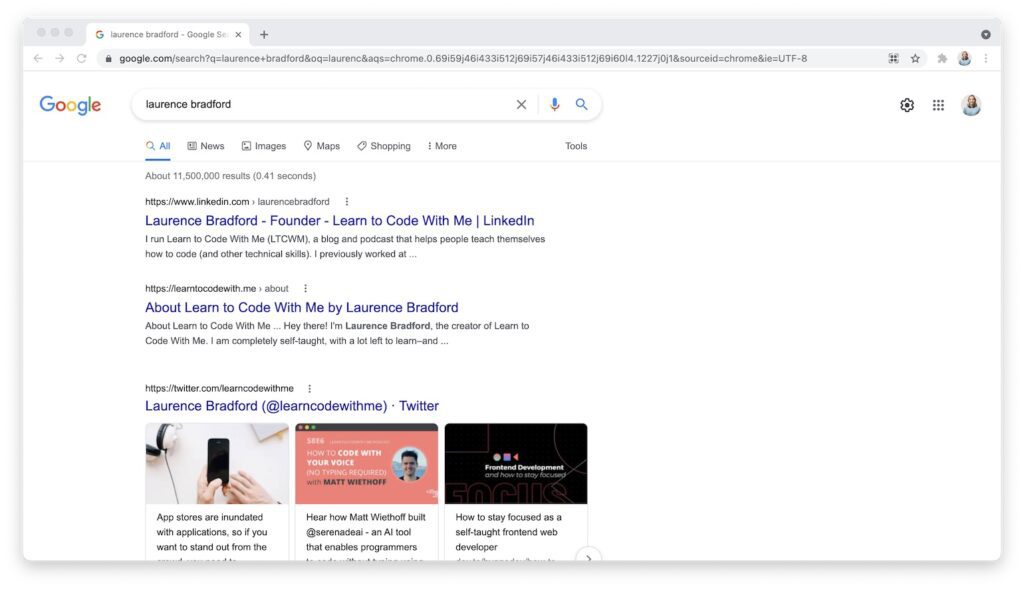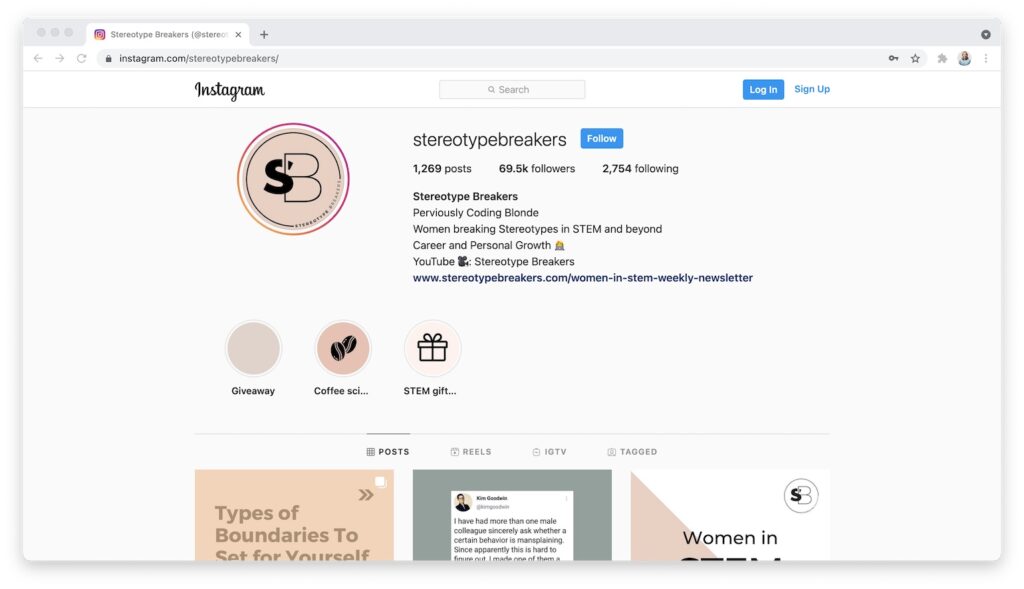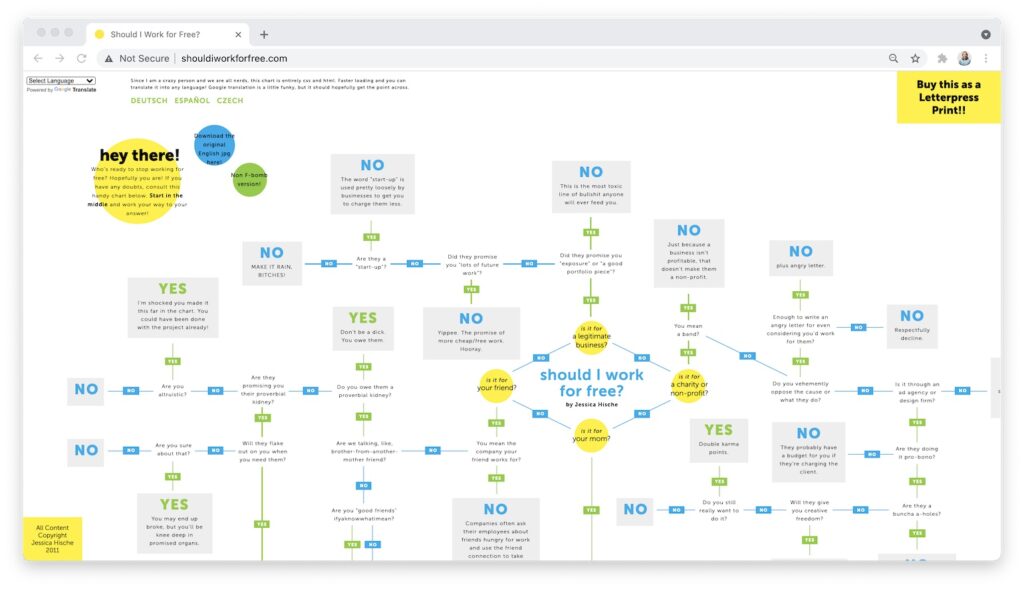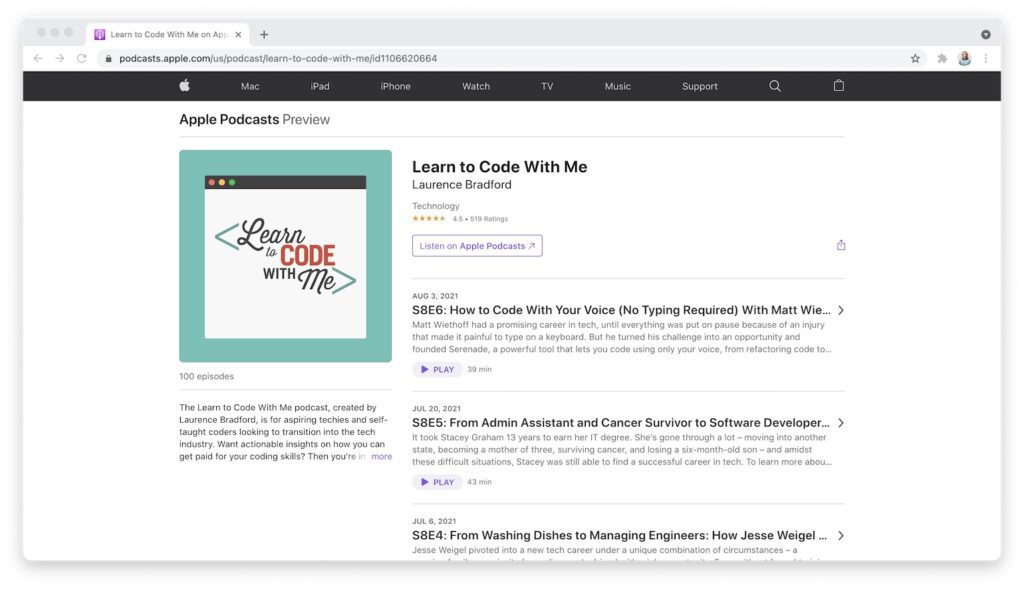If you’re serious about starting a career in tech, I cannot stress enough how important it is that you start building a digital presence sooner rather than later.
Your parents and grandparents have probably told you stories of how they got jobs by putting on a suit and walking into an office with a resume. That’s not the world most of us discovered when we entered the workforce, though. We were told, “Apply online.” You didn’t necessarily have to have your own digital footprint or personal brand for this, though.
Now the landscape is changing again, and by the time you have grandkids, they’ll be equally amazed that you once applied for jobs by filling out form boxes and attaching documents on a website, without creating an online presence.
The fact is, if you are looking for a full-time job or a side gig, sending out online applications is not the most effective way to go about it anymore.
In 2021, there are way better methods of handling your job search or finding freelance work than by blasting out resumes and boilerplate cover letters. (Which is a no-no, by the way. A copy-and-paste cover letter is easy to spot, and even easier for recruiters to delete.)
What’s the method of the future, you ask? It all begins with curating an online presence.
There are many names for an online presence: digital footprint, personal brand, web presence, online profile, etc.
No matter what you prefer to call it, building online presence is important!
In this article, we’ll cover what a digital footprint is, why your online presence matters, and how to create a professional online presence (or how to clean up/improve your online presence if you haven’t been intentional about it in the past).
Disclosure: I’m a proud affiliate for some of the resources mentioned in this article. If you buy a product through my links on this page, I may get a small commission for referring you. Thanks!
Table of Contents
- What Is a Digital Footprint?
- Why Your Online Presence Matters
- 5 Tips for Creating an Online Presence
- How to Improve Your Online Presence Strategically
- Using Your Online Presence to Provide Value
- Other Ways to Get Opportunities
- FAQs
What Is a Digital Footprint?
👣 What does digital footprint mean? Your digital footprint/online presence is the broad picture of the identity you’ve created online — personal and professional. Your internet presence changes each time you publish content, write a tweet, or interact with someone in a public online space.
In a nutshell, your digital footprint is determined by what you publicly put out online. It’s what can be found out about you via online searching. (A private Twitter account or Instagram profile doesn’t count, because not everyone can access it beyond the people you allow.)
Even if you don’t think you have a digital presence, you do. Test it out yourself! To check your online presence, Google your full name (in quotes for best results), plus the town/state you grew up in or live in now. Unless you have a really common name (looking at you, James Smith — which actually beats John Smith these days), you’ll probably find yourself. There’s your digital footprint!

These days, employers expect you to have a digital footprint, especially if you’re a developer, software engineer, or other techie. And if you’re going to freelance, your online presence is largely how you’re going to attract and land clients.
In fact, nowadays, 77% of employers are Googling and otherwise researching job applicants. What appears in the search results is your online presence, or digital footprint. And if literally nothing appears — it raises eyebrows.
☝️ Back to the table of contents
Why Your Online Presence Matters
Maybe your digital footprint is already great…or maybe it’s a little lackluster. The good news is that it’s easy to take control of, and reshape, how you appear online.
Your online presence is powerful. It can show you who are, help build trust and credibility, show that you’re passionate, and make you stand out from the pack. (Or, on the flip side, it can make you stand out in a bad way…when you forget to delete that one profile picture on Facebook from that party.)
Having in-demand skills and experience is great. But if people don’t know you have amazing skills, jobs and connections won’t exactly be falling into your lap. Put yourself out there, so the world can see.
An online presence is a networking tool, too. A strong one goes a long way in helping you connect with more people — peers, influencers, and decision-makers.
As an example, Masha Zvereva started Coding Blonde (now called Stereotype Breakers), got a job at Google and now does influencer marketing with Stereotype Breakers full-time.

I’m another example! I started LTCWM years before I applied for my first full-time job in tech. My blog where I write about learning to code helped me land a job at Teachable – an EdTech startup. I didn’t need to convince hiring managers I was passionate about online education; my site proved that. Even though I didn’t necessarily “check all the boxes” on their lists of job requirements, that underlying passion spoke a lot louder than a few missing skills.
☝️ Back to the table of contents
5 Tips for Creating an Online Presence/Personal Brand
Many components are involved in the process of building a solid web presence. Below are a few of the most common, and effective, ways to improve online presence. Whether you have no online presence and want to build one from scratch, or you want to clean up your online presence and build a professional personal brand, these tips can help.
1. Build a personal website/portfolio 💻
This is step one of how to build your personal brand online. Everything starts with having your own website. You need a dedicated place online that tells people who you are and what you do.
A website or portfolio site is an ideal place to outline your vision/skillset, show examples of your work and resume, and make your contact information available. Make an about me page to introduce yourself and highlight your goals, experience, and personality.
Unless you have a business with its own name, use your full name as the URL. If the .com extension isn’t available, you have plenty of other options — .net, .org, .me, and many more. When you register a domain, you own it.
Find out why you should use WordPress for your first website (and why Kinsta is my favorite choice for hosting). You can also start with something simple like https://about.me/.
Or, check out these helpful online portfolio website examples here.
2. Brand yourself 🎨
Once you’ve set up a website, you’ll also want to get to work creating the aesthetic of your personal brand. While you don’t need a logo or brand colors when you’re first getting started, narrowing in on a style or branding elements that help you stand out and represent who you are can be beneficial.
Check out Creative Market, a marketplace for design assets like fonts, graphics, and website templates, to get started.

3. Use social media 📱
Technology professionals should have an online profile on LinkedIn and GitHub (if you write code) at a minimum. Joining Twitter and Instagram, or creating a Facebook group/page can be a good idea, too, provided you have the time and content to post regularly on them. (Designers, also look into Dribbble and Behance.) TikTok or YouTube can also be good social media platforms to join if you like creating videos.
LinkedIn is especially important if you’re looking to land a job. Danny Thomspon went from frying chicken to working at Google by using LinkedIn. Caitlyn Greffly also leveraged LinkedIn to transition from beer sales to software engineering. Here are some tips for how to take your LinkedIn profile to the next level.
Plenty of developers use social media to build a following to augment their professional online presence. Here are a few examples to draw inspiration from:
- @theaigirl on Instagram
- @anna.tech on Instagram
- @the_dvlpr on Instagram who I interviewed here
- @gazi.ai on TikTok
4. Create content ✍️
If you’re a good writer (or even a passable one), start blogging. Usually, this will be done on your website, but you can also choose to publish on a platform like Medium, Dev.to, or freeCodeCamp.
Focus on creating quality content that is valuable to others; this will help your blog (and thereby you) develop a following. Here are some tips for getting people to pay attention to your blog.
If writing isn’t really your thing, that’s fine. Thanks to modern technology, it’s easier than ever to start podcasting, design graphics/illustrations, or create videos. Here are some additional examples of content you could create:
- Post photos of your life/work on Instagram
- Take photos and review products or tech gadgets
- Create TikTok videos or Instagram reels
- Start a video journal or vlog on YouTube (unboxings, day in the life, and office tours are often popular)
- Design and sell products online (here are 20 of the best e-commerce platforms)
- Create and post funny or relatable memes and gifs
- Design cartoons, illustrations or infographics (example: @futurismcartoons)
- Write and post poetry (example: @quarterlifepoetry)
- Interview people about a topic you’re interested in or want to have a career in — you don’t need to know much and you’ll learn along the way and make connections
- Send out a weekly or monthly email newsletter (ConvertKit and MailChimp are great options to get started)
- Create other artwork/creative content — paintings, newspaper blackouts, bullet journals, etc.
- Give your take on something generic (like learning to code, working in tech, etc.) informed by your unique personal experiences and the things that make you you (e.g., nationality, gender, sexuality, previous job title, etc.)
5. Build projects 🧑💻
Adding projects or code to your GitHub provides evidence that you know what you’re doing — the “showing your work” equivalent of the working world. This adds even more credibility to your online presence.
Start by building a mini app, or helpful library (like the Toast grid system). Or create other kinds of side projects (for yourself or others), like Jessica Hische’s shouldiworkforfree.com.

Max Eccles documents his learning journey by building projects in public. He is currently bootstrapping a SaaS tool with no budget, beginner coding skills, and less than 15 hours per week. Check out his progress here. As a bonus, doing something like this out in the open on the internet can get you supporters/followers for your project.
There are, of course, more ways to build your online presence than just those four. Remember, your online presence is anything that can be searchable online. As long as it’s online and public, it counts.
It’s easy to feel overwhelmed. So many options, what path to pursue? The answer: where you put your attention depends on your goals.
☝️ Back to the table of contents
How to Improve Your Online Presence Strategically
Don’t just build your internet presence because it’s something you’re supposed to do. Be strategic about it. Build your personal brand in a way that will help you reach your career goals. Otherwise, you’re just wasting time.
The first step in strategically creating an online presence is to pinpoint exactly the kind of job you want. What industry? What company? What will your role be? What will the hiring manager who interviews you care about?
When you have a target in mind, it’s a lot easier to be deliberate in the online presence you create.
Want a job as a web developer? Build projects that align with the kind of jobs you want, using the programs and technologies that the job requires. Post them on GitHub publicly. Or contribute to an open source project. Or write blog posts that pertain to some aspect of the job. Check out this podcast episode on coming up with coding projects for more ideas.

Want to be a web designer? Similarly, design stuff that aligns with the kinds of jobs you want. (If you want to work in the food industry, like at GrubHub or Doordash, for instance, design food-related things — icon sets, infographics, even presentations.) Get on design-specific platforms like Behance and Dribbble. Write blog posts about design topics that will attract decision-makers at the companies you want to work for. Add these things to your portfolio site.
The topic doesn’t have to be coding! In fact, when you couple two things together, it can make you stand out more. I like to call it “passion mashing.” Think about what your interests and obsessions are and find a tech-y spin on them.
🍜 For example, if you’re a big foodie and you want to be a web designer, try designing your own recipe blog or restaurant review site. Apply to jobs at companies like Grubhub or DoorDash or Blue Apron, and you’ll likely stand out way more than the other web designers.
🧗 Love bouldering and want to get into app development? Build a searchable database of local/national climbing centers.
🌡️ Passionate about studying climate change and want to get into data analytics? Carry out your own research using publicly available data and blog about your findings, share your data visualizations on r/DataIsBeautiful, or post research-backed infographics on Instagram about how ordinary people can make a difference.
If you want to be, do. Just make sure to highlight what you do on your personal site, so you can show it to the world!
☝️ Back to the table of contents
Using Your Online Presence to Provide Value
Whatever your target is, there is one sure way to get discovered, build a brand, and put your name on the map: provide value. Create valuable content, and people will naturally share what you’re doing with others, and will want to reach out to connect with you.
Ultimately, the way to really boost yourself is to think about other people before yourself. Websites, social media, etc. are important, but not as important as establishing yourself as a vital part of your community by contributing insights, ideas, and help.

When you use your online presence to create value through blog posts or even just helpful conversations on social media, it will leave behind a digital footprint that showcases your competence and initiative. Go beyond being an internet “consumer” of information by contributing your own ideas and thoughts, and helping others.
You don’t have to be an expert to provide value, either. It can be as simple as building an app or doing an experiment, and documenting the process, including any mistakes and how you learned from them. Or posting about upcoming industry events or interesting news. Or researching a question someone asked to see if you can solve the problem they’re having. Or even entertaining your audience through funny and/or relatable videos, vlogs, podcasts or online journals on topics you’re passionate about.
When you consistently create value, you build authority in your industry, which translates to increased visibility. And by putting out quality content, you build trust, which allows you to build relationships with others in your industry/field. For instance, starting the LTCWM podcast has allowed me to connect with so many awesome peers I maybe never would have otherwise!

☝️ Back to the table of contents
Yes… There Are Still Other Ways to Get Opportunities
Not everything is online (yet). In-person networking is still a very viable option. Without a doubt, meeting someone in person, at a workshop, happy hour, or the like, is the fastest way to build a meaningful connection.

However, there’s a few drawbacks to in-person, or one-on-one networking.
- You can only meet the people in the room with you — you’re confined to that crowd. When you’re online, you can connect with anyone.
- You have to live in an area with networking events to go to! Sure, if you live in SF, or NYC, or any other urban area, there’ll be tons of people to meet. But what if you live in a less populated area? Or an area without much of a tech community? You’ll be out of luck. Not so online.
Even if you do live in a big city, with tons of networking events to attend and conferences and so forth, you can’t afford to neglect your online presence. So much of building a strong professional network, and maintaining relationships (even ones initiated in person), is done online. Through LinkedIn, email, Twitter, and so forth.
And more than that — how many people do you think will still Google you after you meet at an event? I’d argue most, if not all, will. (I know I do! After connecting with someone in person, I almost always Google their name and try to find them online. And my opinion of them won’t be positively influenced if the search results appear empty…or if all I find is an outdated website, lackluster LinkedIn profile, etc.)
So even if you’re going out and meeting others in “real life,” having a web presence matters a lot.
☝️ Back to the table of contents
FAQs About Creating an Online Presence
Let’s dive into some frequently asked questions about online presence management.
How do you find out what the internet knows about you?
To check your online presence, you can do a quick Google search to see what the internet knows about you. Type in your first and last name, where you live or have lived, your email address, and/or other identifying information, and see what comes up.
You can also set up Google Alerts for when your information is detected somewhere. This makes it easy for you to monitor your online presence.
How can I clean up my existing online presence?
To clean up online presence relics from your past, start by auditing your current social media accounts. Go through any inappropriate photos of you online, any embarrassing Facebook posts you made in high school, old YouTube videos, etc. and delete them or make them private. Consider deactivating any accounts you no longer use and unfollow questionable accounts.
Should I make my social media profiles private?
You can certainly keep some of your social media profiles private if you only wish to share certain things with friends and family. But remember that those accounts will not count towards your online presence, as the public will not be able to see your content. You may want to have a dedicated personal account that you keep private, and a professional account visible to the world.
What makes a good online presence?
A good online presence is one that clearly shows what a person is all about. People who have a good web presence don’t need to have a high follower count, but they should be connecting and engaging with their target audience. When someone has an effective internet presence, all you’ll need is a quick Google search to get to know what a person is interested in and what they’re an expert on.
How do you maintain an online presence?
Consistency is key when it comes to maintaining an online presence. The ideal frequency depends on the types of platforms you’re on. For example, many people see success when posting every day on Instagram stories. However, on YouTube, posting once a week may be effective. Posting a blog post once or twice a week is also a good rule of thumb. Just make sure you’re also posting quality content.
Do I have to be on every social media platform?
No, you definitely don’t need to be on every social media platform to have an effective online presence. However, it can be helpful to be on multiple platforms. Quality and consistent content is key, so don’t overextend yourself by posting on tons of different platforms. Instead, consider choosing two or three platforms to focus on (e.g., Instagram, blog, Twitter) and post great content there, rather than trying to post on every platform out there.
☝️ Back to the table of contents
Start Building Your Online Presence Today
Building an online presence takes time. It’s not a quick run to the finish line; it’s more like a marathon. But if you start building an online presence now, you can leverage it well into the future. A digital presence is like compounding interest: the sooner you start, the more valuable that initial investment will become over time.
Remember, though, that the flip side is true as well: the longer you wait to begin creating an online presence, the longer it will take to reach your goals.
And regardless of your end goals, having a personal website is like the nerve center of an online presence. It’s the core from which you build your name and your personal brand.
Especially when you’re not ready to even think about starting a business or anything so formal, a portfolio website is the perfect way to start establishing an online identity and showcasing your skills.
To help you get started, I created my free portfolio course. It’s built specifically for aspiring designers and developers who aren’t sure where to start with a portfolio site, and want to avoid the mistakes and pitfalls that have sabotaged those before them.
➡️ Sign up for my FREE portfolio course below, and start building an online presence you can be proud of!

